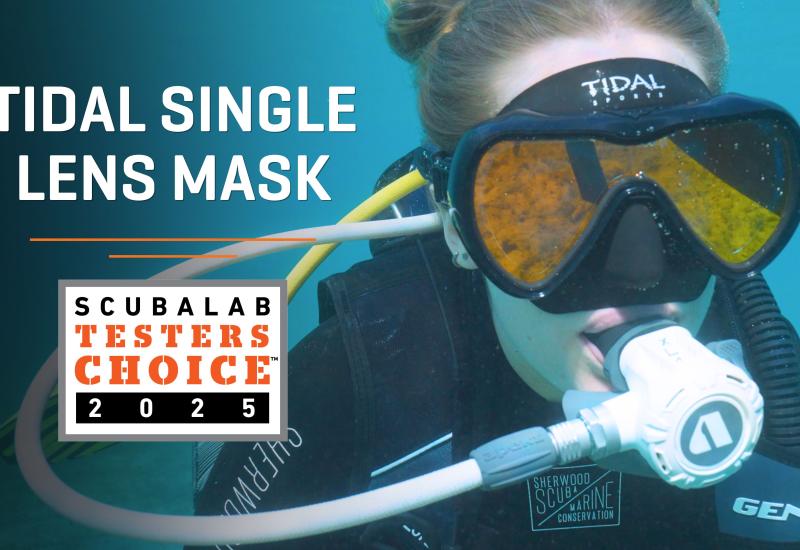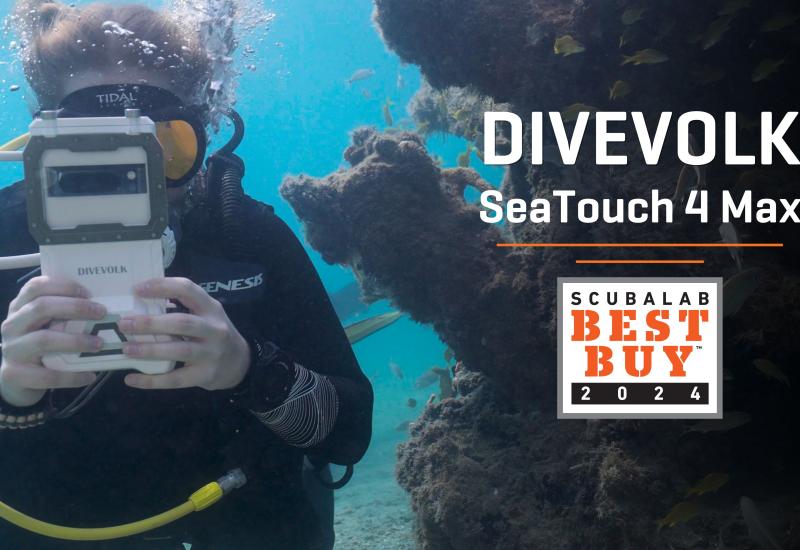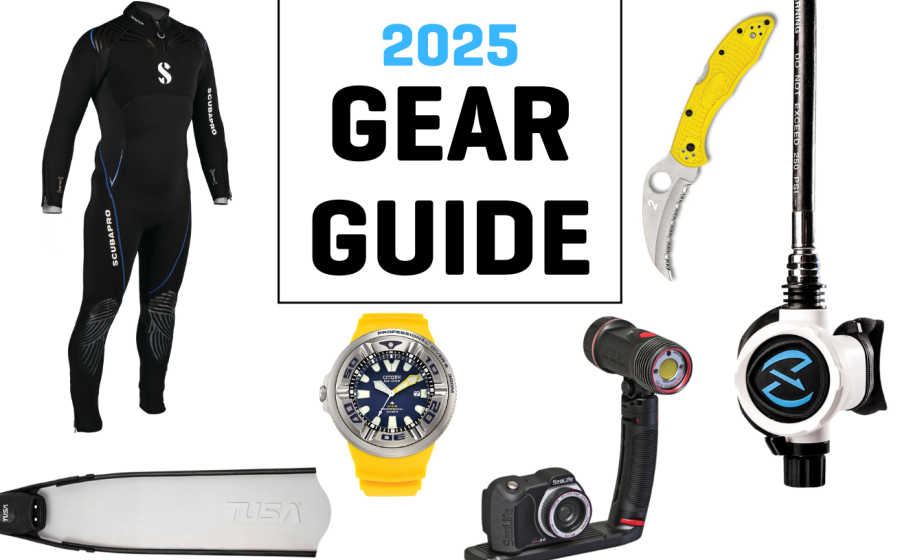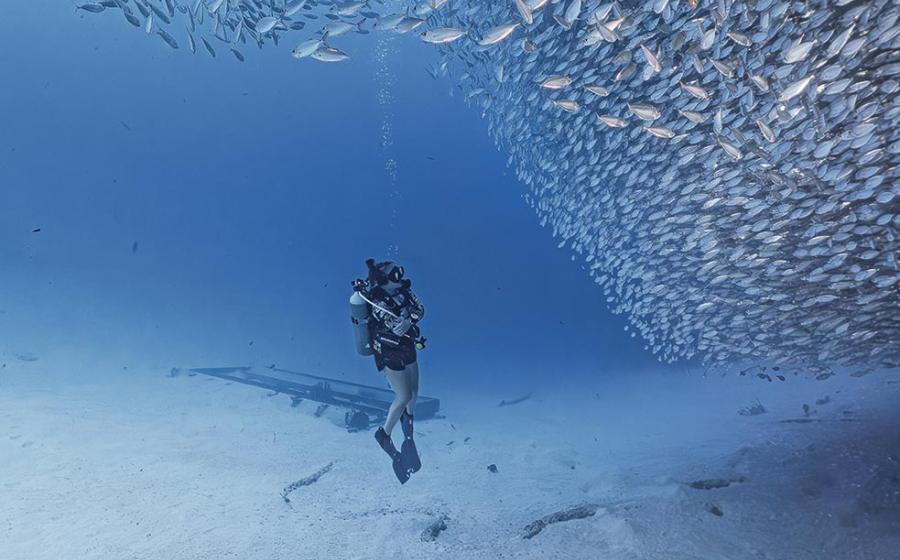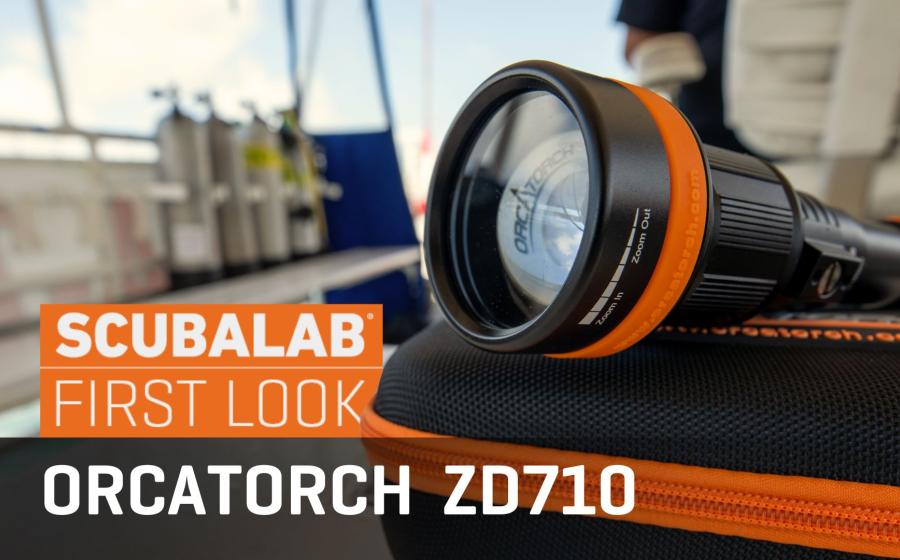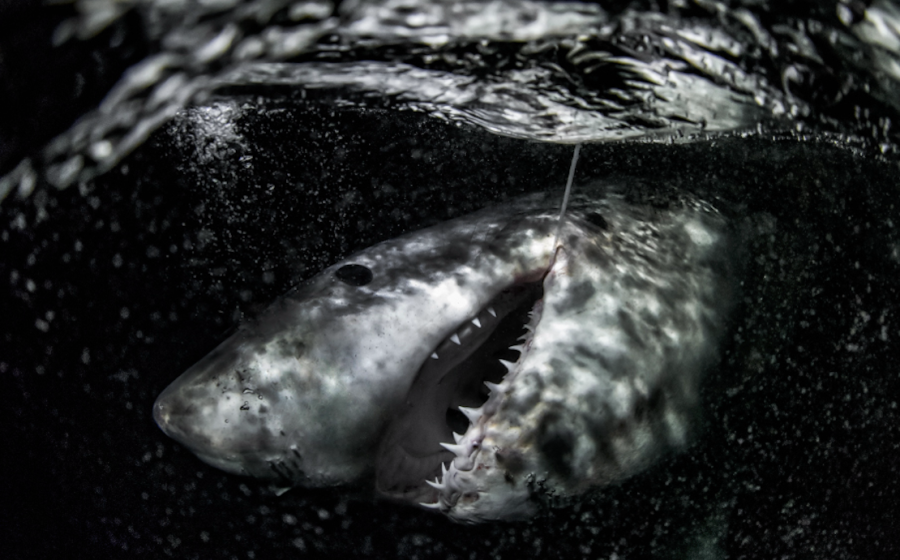Best Underwater Housings for Smartphones

Divers tested six new phone housings
Head-To-Head Testing
How We Test
ScubaLab tested underwater smartphone housings using an iPhone XR and iPhone 14 during freshwater dives at Blue Grotto Dive Resort in Williston, Florida. Dives were conducted using the housings hand-held and outfitted with a tray and video light. Test divers scored each housing in several categories using the following scale: 1 = poor, 2 = fair, 3 = good, 4 = very good, 5 = excellent. The categories were as follows:
Build Quality Is the housing durable and reliable? Would you trust it with your phone?
Setup How easy is it to prepare the housing and phone for diving?
Ergonomics Are controls accessible, responsive and comfortable? Is the grip comfortable and secure?
Intuitive Operation Do the controls and menus make sense? Can you understand the display and indicators?
Media Quality Are images and videos consistent with what you would normally expect from the phone being used? Do images and videos contain glare or other artifacts?
Battery Life Do the phone and housing batteries seem to last a reasonable amount of time?
Special Features Does the housing have any noteworthy features to improve images or the user experience?
Post-Dive Does the app have any topside functionality?
We also evaluated housings’ relative drain on phone batteries. For each housing, we installed a fully charged smartphone. The phone was left idling in the housing with sleep mode deactivated (if applicable) for 15 minutes. We then took 10 still images and recorded fi ve 30-second video clips with the device. Finally, we let the phone idle for an additional 15 minutes with sleep mode enabled before removing it from the housing. We also checked the buoyancy of each housing in fresh water, without a phone inside.
Each review lists the app version used during our testing. New updates may have become available for some housings prior to publication.
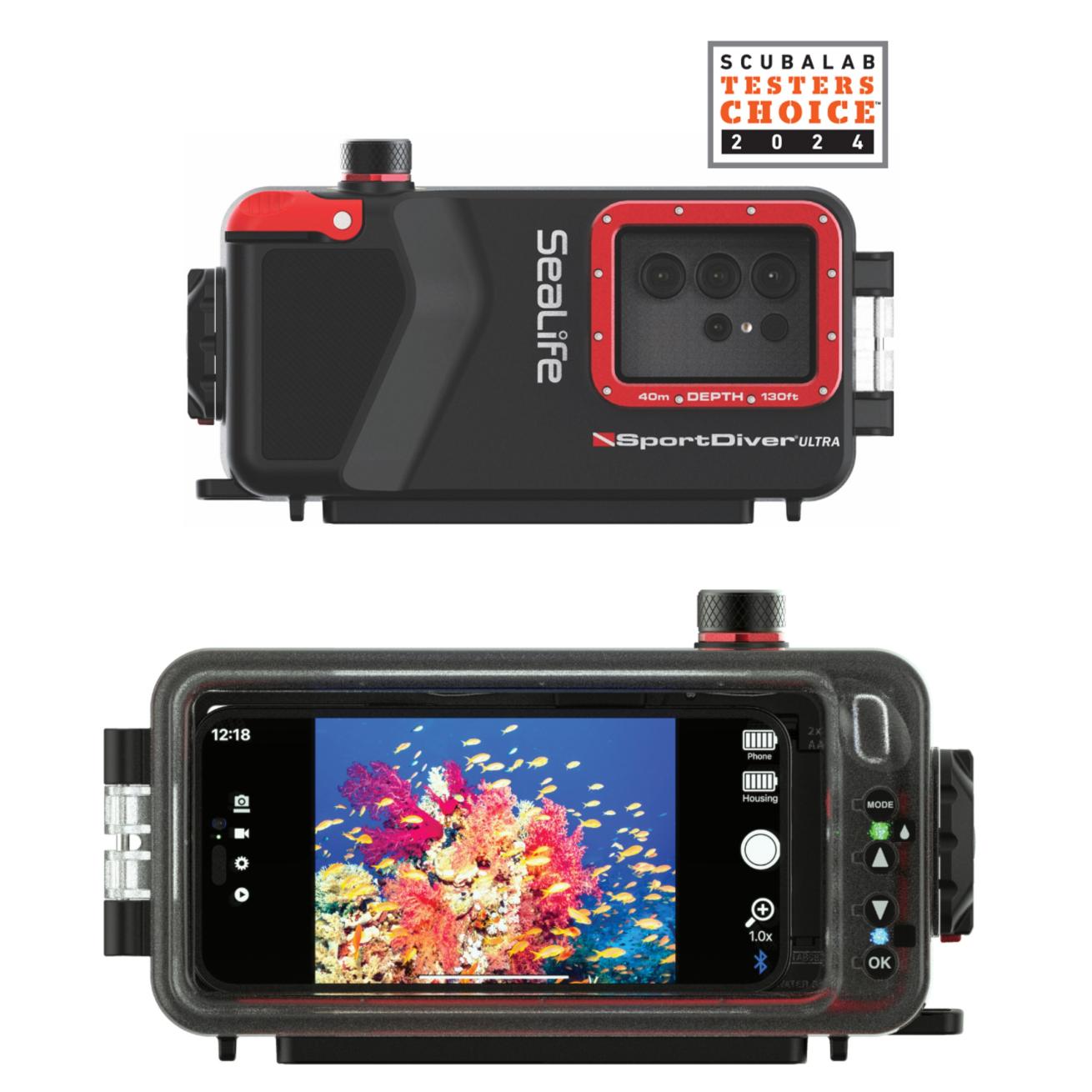
Smartphone Housings
SEALIFE
SportDiver Ultra
Slightly larger than the original, this update of the SportDiver housing is compatible with most Android phones, including all larger Samsung S Series Ultra models, Google’s Pixel range and all iPhones from 8 through 15 Pro Max. Testers were extremely confident in its build quality, which uses polycarbonate, stainless steel, aluminum and optical-grade glass. It includes a vacuum seal with dual leak alarms.
The housing’s large camera-like shutter control, wellplaced thumb rest and stocky grip are great hand-held or on a tray. It has multiple ¼-20 mounts. Test divers were impressed with the firm, responsive push buttons, which provide an audible, tactile “click” when pressed. Setup is very straightforward, with very clear instructions for setting up the vacuum seal, but it can sometimes take a minute or two to establish the Bluetooth connection. Menu operation is self-explanatory, and users will never find themselves more than two menus deep. Settings can be kept simple for a hassle-free point-and shoot experience, but there are more advanced options like manual white balance using a selected color temperature, manual focus, and video settings up to 4K at 60 fps.
Zoom and focus can be accessed via shortcuts while shooting. Playback mode provides quick access to full-resolution photos and videos taken via the app. The housing supports physical color filters (a red one is included) and a snap-on wide-angle lens for easy split-shots at the water’s surface. An optional adjustable adapter allows users to add 67 mm and 52 mm wet lenses for even more capabilities. Versatile, robust and refined, the user-friendly SportDiver Ultra was a favorite of test divers. It is our Testers Choice for underwater phone housings.
Read the full SeaLife SportDiver Ultra Review and video here.
MSRP $349.95
CONTACT sealife-cameras.com
SPECS
Depth 40 m. / 130 ft.
Weight 1 lb. 12 oz.
Buoyancy Positive
Battery 2x AAA
App version V3.4.4
Device iOS, Android
PRO: Great ergonomics and user-friendly operation, advanced functionality and accessories, vacuum with seal check
CONS: Depth-rating not as high as some others
"Very easy. Anyone can use it."
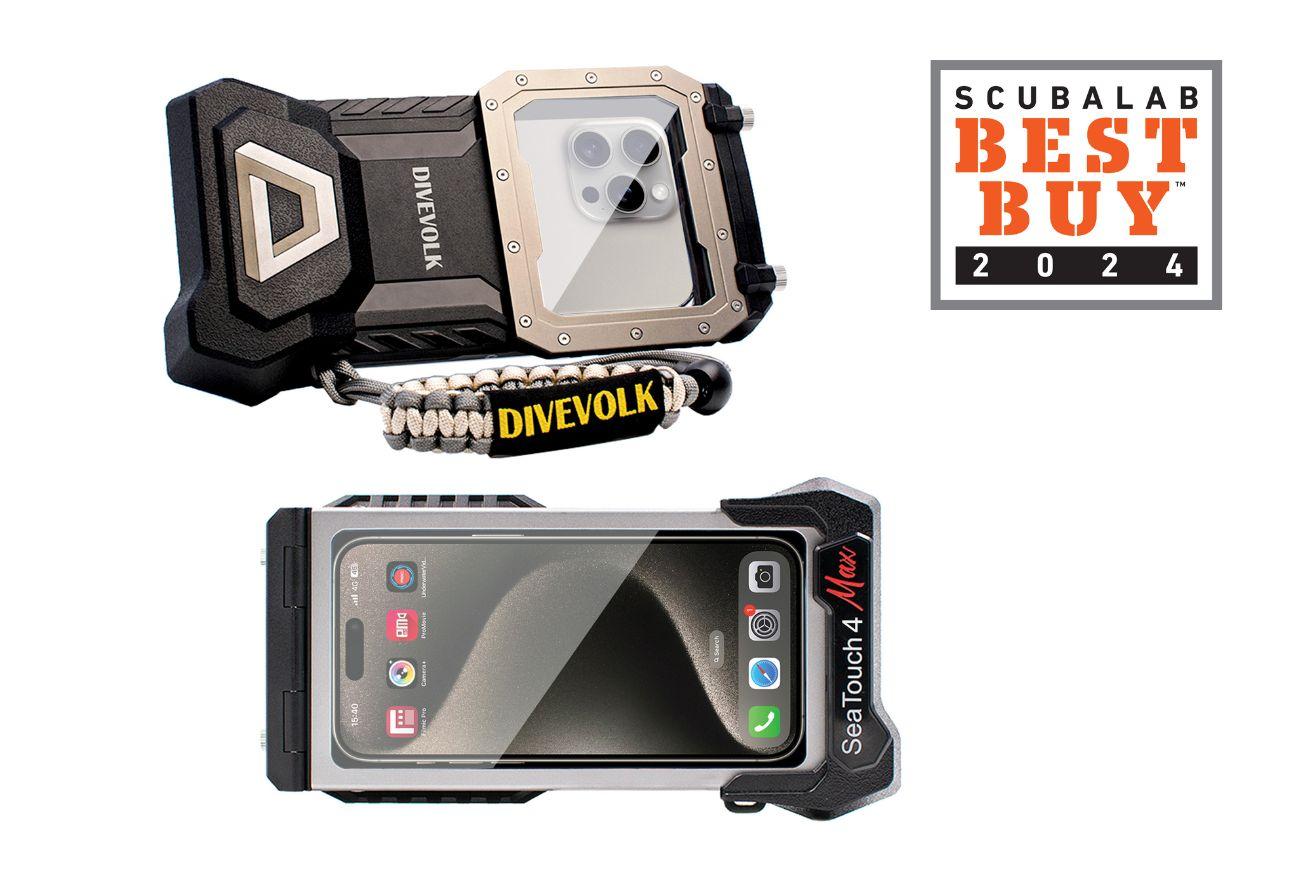
DIVEVOLK
Seatouch 4 Max
Outfitted with a soft, flexible membrane, this housing offers full touchscreen control for the user’s smartphone. It is depth-rated to 196 feet, but care should be used to protect the membrane during travel and storage. A travel case is not included. Users can access their phone’s native camera app—along with any other app—so no dedicated housing app or battery is needed. Simply place the phone into the plastic tray, slide it into the housing and secure the thumbscrews. Adapters for various models of the iPhone 12, 13 and 14 are included. Other models will require the purchase of a customized adapter or some jerry-rigging for a secure fit.
The housing scored excellent for operation, as your phone can be used just like it would be on land. The only exception is that users will need to turn on the device’s adaptive touch settings to lock the screen. Phone battery life is also the same as what one would normally expect. The housing is slim, except for its right-hand grip, and super lightweight. It is comfortable and natural to hold in the hand. Additional accessories are required to use the housing with a tray, color filters, wet lenses and imaging lights. There is also a Wi-Fi signal transmitter accessory, which can connect the phone to a camera for use as an external monitor.
Test divers felt there was a lot of functionality available even beyond imaging: Easily reference site maps, watch movies during extended decompression stops, communicate via text or calls at the surface—the possibilities are endless. Super compact, this travel-friendly housing offers streamlined imaging capabilities and versatile functionality for diving and other watersports. The SeaTouch 4 Max was a favorite of several test divers and is our Best Buy.
MSRP starts at $229
CONTACT krakensports.ca
SPECS
Depth 60 m. / 196 ft.
Weight 1 lb. 2 oz.
Buoyancy Positive
Battery N/A
App version N/A
Device iOS, Android
PRO: Full touchscreen control, no battery or electronics, super versatile, very lightweight and compact
CON: Requires additional components for anything beyond hand-held use
"Your phone underwater. Just how you like to use it."
Why Buy?
SIMPLE point-and-shoot operations, combined with the high-quality processing power of modern smartphones, makes taking quality underwater photos and videos accessible to even the least camera-savvy divers.
COMPACT compared to many underwater cameras, these housings aren’t much larger than the smartphones that sit inside them and weigh no more than 2 pounds. This makes them very easy to travel with and very easy to carry during a dive.
SHARE and edit images and videos immediately after surfacing. All of the housings in our test save media directly to the phone’s camera roll—no downloads required. You can access them just like any other media taken on your smartphone.
COMPATIBLE with a wide variety of phone brands and models, these housings are reasonably futureproof. As users upgrade to the latest Android or Apple smartphones, odds are good they’ll be able to continue using their existing housing without an issue.
Related Reading: Best Scuba Regulators of 2024 Reviewed

KRAKEN
Universal Phone Housing V2
Made of anodized aluminum and other heavy-duty components, this housing impressed with its excellent build quality. It has a vacuum port with leak detection and is depth-rated to 280 feet—the deepest of the test. Its grip and oversize shutter control make for a great hand-held or tray-mounted experience underwater. The app is very intuitive, but runs noticeably smoother on newer phones. Users can quickly access ISO, focus and zoom, and adjust each incrementally while diving.
Settings for media quality must be set ahead of time, and media cannot be reviewed during a dive. The Pro version has a depth sensor, and will display depth, water temp, dive time and compass heading. The housing’s rechargeable battery can charge the user’s phone while it’s inside the housing. This lets users extend imaging time during a dive or simply charge up the phone while it sits in the housing post-dive. Batteries can be swapped without compromising the seal, so a large supply will let users keep their device running all day long. Color-coded indicator lights are easy to see but require users to commit their meanings to memory.
Foam padding and a reusable sticky pad are included to secure phones in the housing. The sticky-pad method is very straightforward, but the pad will eventually need replacing. The vacuum port position can make it awkward to pump while keeping an eye on the indicator light. Snap-on color filters and an adjustable wet lens adapter are available. The Kraken’s robust build quality, advanced functionality and built-in battery charger made it a favorite of multiple divers. Future updates will add dive logs and advanced image editing tools like AI color-correction.
MSRP $399, $499 (Pro)
CONTACT krakensports.ca
SPECS
Depth 85 m. / 280 ft.
Weight 2 lb. 2 oz.
Buoyancy Very negative
Battery Removable, rechargeable 18650 lithium-ion battery
App version 2.2.0
Device iOS, Android
PRO: Super durable, rated for extreme depth, advanced functionality and accessories, phone-charging via removable battery
CON: Heavy, awkward vacuum port location
"Built-in battery charger is genius."
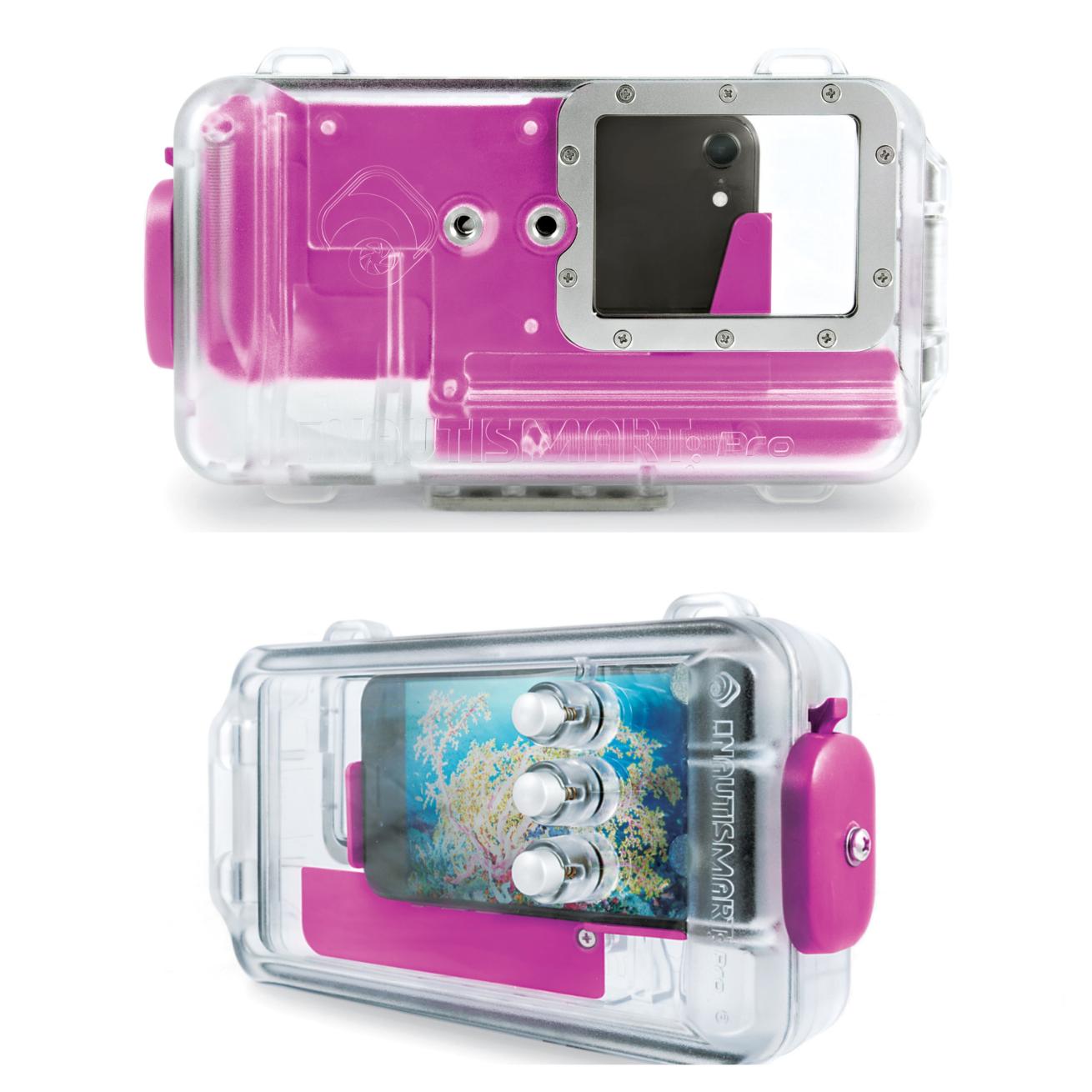
NAUTISMART PRO
This housing has no batteries or Bluetooth to fiddle with. Instead, three touchscreen-compatible buttons are used to interface with the housing app. Two spring-loaded clamps, a removable spacer, and a simple button-mapping sequence offer a secure, near-universal fit. The whole setup process can be completed in just a few seconds. The lightweight, compact housing uses optical quality PVC, anodized aluminum and high-quality polycarbonate. There is a decent grip incorporated into the right side of the housing. All controls, including shutter, are on the back.
Operation is self-explanatory and includes a shortcut to quickly cycle between video and photo modes and the selfie camera. Divers can quickly and easily review the 20 most recent items on the phone’s camera roll. The cyclical settings menu always opens with the last used item. The order of the items seems less than logical—it often feels like the button-mapping option and other settings needed during setup are spaced in between many of the more “in-the-moment” settings. Fortunately, there isn’t much to sort through besides video quality, white balance and zoom. Even then, white balance options are limited to traditional topside options, with no underwater modes, so auto will suffice in most cases.
The app does include a rudimentary battery-saving mode, which will shut off the phone until it is removed from the housing. The housing has a ¼-20 mounting plate and includes a screwon adapter for 28LD-mount wet lenses, allowing greater versatility for wide-angle and macro subjects. The Nautismart Pro’s reliability, streamlined simplicity and budget-friendly price make it an attractive option for any diver looking to turn their phoneinto a no-fuss underwater camera without breaking the bank.
MSRP $249.99
CONTACT nautismart.net
SPECS
Depth 60 m. / 196 ft.
Weight 1 lb. 7 oz.
Buoyancy Positive
Battery N/A
App version 1.2.4-51
Device iOS, Android
PRO: Compact, simple operation, no electronics or battery to worry about, included wet lens adapter
CON: No vacuum seal check, limited image control
"Loved the ease of setup and simple app."
Related Reading: SeaLife SportDiver Ultra Smartphone Housing: ScubaLab Testers Choice
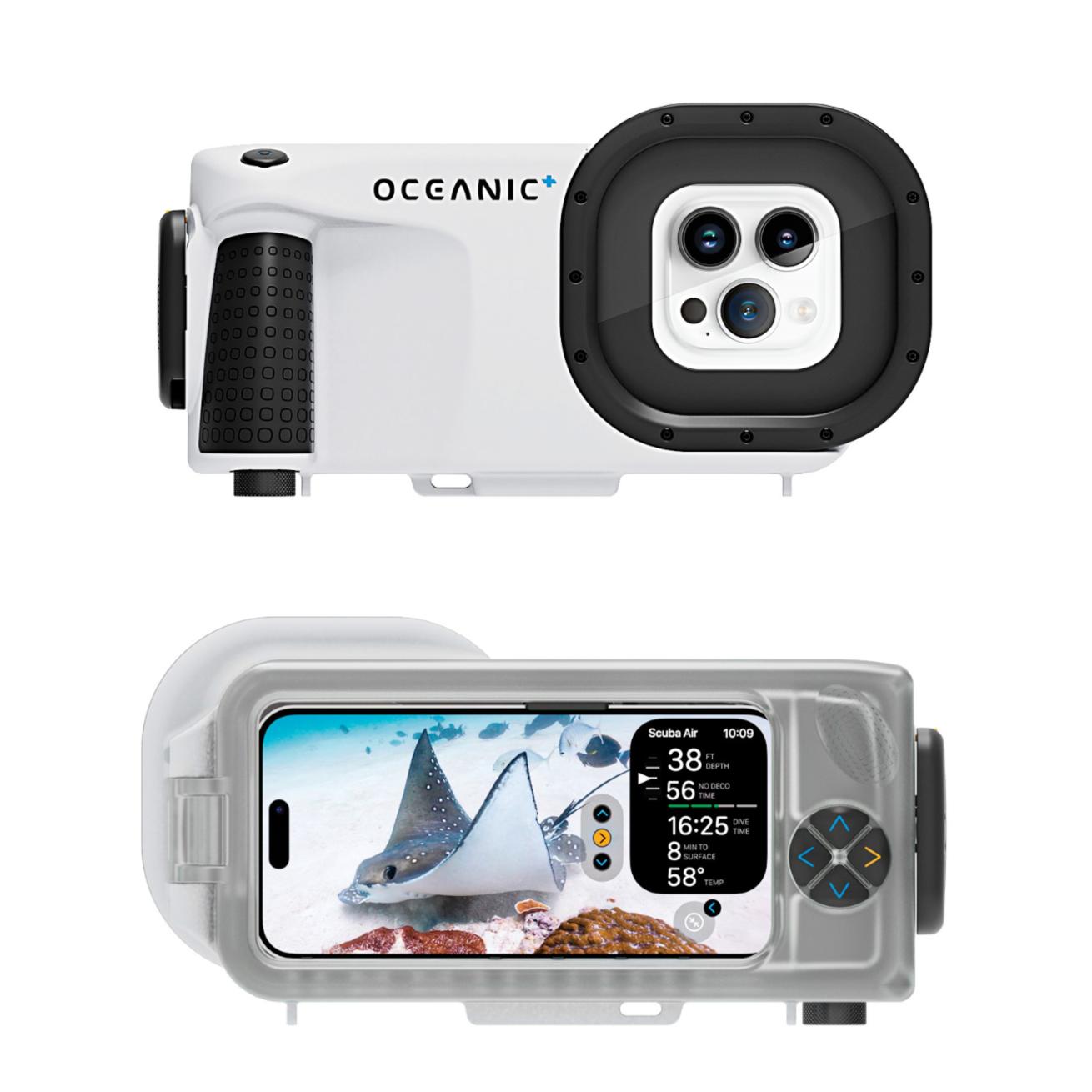
OCEANIC+
Dive Housing for iPhone
Made of a fiberglass-reinforced techno-polymer material, this iPhone housing is super durable, impact-resistant and has an automatic vacuum pump with no loose parts. The shutter and four-button directional pad are well-placed, but the D-pad buttons can be stiff to operate. Step-bystep walk-throughs ensure the phone is installed correctly and that the seal is free of leaks. The in-water display is clear and simple. Menu navigation is very intuitive but requires many button presses. Some small tweaks like a shortcut back to the main menu or the ability to cycle from the bottom of a menu back to the top would help.
Users can set RAW imaging, aspect ratios, video formats up to 4K at 30 fps, stabilization, and exposure while diving. A color-corrected overlay is available while diving, but it is just a preview. Users can review still images from the current dive, but they are organized in a seemingly random order. With a premium subscription, the app includes a full-fledged dive computer overlay identical to the Apple Watch Ultra version. The app seems to tax the phone more than others in the test and doesn’t display the phone’s current battery level.
When the app works, the results are effortless. However, we did have recurring issues with the app quitting unexpectedly during a dive. Postdive, the app can be used to enable auto color-correction to any media in the camera roll and displays shareable dive logs with embedded media taken during the dive. This housing has a lot to love, even without ponying up for a subscription. The robust construction and easy operation make it a solid choice for iPhone users, especially those already equipped with an Apple Watch Ultra.
MSRP $489.95 (doesn’t include premium subscription)
CONTACT oceanicworldwide.com
SPECS
Depth 60 m. / 196 ft.
Weight 2 lb. 4 oz.
Buoyancy Slightly negative
Battery Built-in rechargeable battery
App version 2.0.16
Device iOS
PRO: Full dive computer overlay, RAW imaging, built-in automatic vacuum seal check with no loose parts, auto color-correction
CON: iPhone only, subscription required for advanced media editing and full dive computer, app needs some polishing
"Super clear directions and great visuals!"
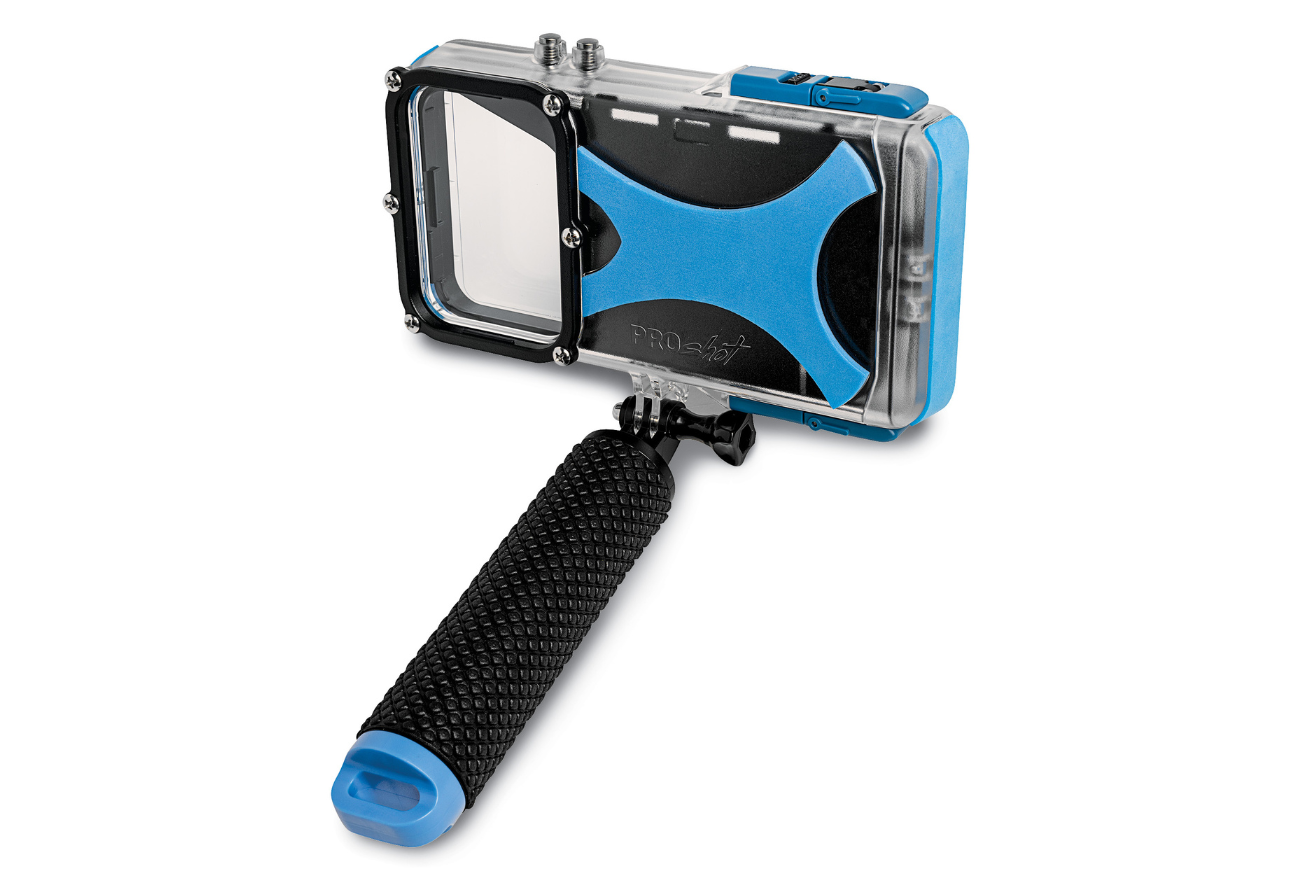
PROSHOT
Dive Universal iPhone Case
This iPhone housing fits all models from the iPhone 6 onward and uses the phone’s volume buttons to control the dedicated iOS app. In-water controls are limited but super simple and intuitive; users can activate the shutter, cycle between camera modes, and zoom in and out. Settings, including RAW imaging, video quality and “bright sun” mode, must be selected via the touchscreen prior to installation. Users can also enable or disable specific camera modes to streamline operation. Images can be reviewed post-dive with the touchscreen.
The thin, flat housing is lightweight in the hand but doesn’t include a built-in grip. That, along with the top-mounted buttons, made for awkward ergonomics during use. When shooting hand-held, results often inadvertently included user’s fingers in frame. The housing uses a GoPro-style mount, making it compatible with most action-camera grips and accessories. It is positively buoyant, especially when using the included floating hand grip, making it suitable for snorkeling and other watersports. Preparation is simple and straightforward, but the tiny dual cam buckles can be difficult for larger hands. ProShot offers an underwater video light that can be mounted directly under the housing and color filters for light and housing alike.
This housing seemed more prone to glare than others in the test, while the app seemed to have the least amount of drain on the phone battery. Divers looking for a robust photography experience won’t be satisfied with the ProShot’s limited controls. But it makes an attractive option for divers who want to improve their underwater snapshot game without adding a lot of complication or spending an arm and a leg.
MSRP $159.99
CONTACT proshotcase.com
SPECS
Depth 40 m. / 130 ft.
Weight 12 oz.
Buoyancy Very positive
Battery N/A
App version 7.7
Device iOS
PRO: Simple operation, no electronics or battery, watersports-friendly, RAW imaging, one-year iPhone protection guarantee
CON: No vacuum, awkward ergos, iPhone only, limited control
"Super simple and easy to use."
Ask Robby
Q: How did image quality differ from one housing to another?
A: While some apps do provide higher image and video resolutions, including RAW imaging, the real quality of the images and video will be determined by the smartphone. Older models will work with most housings, but some features may not be compatible. Newer devices will provide more features, the highest-quality media, and snappier response times. Housing apps are generally free to download. Download them to get a feel for how well they run on your device—and check out any newly updated features that have been added while you’re at it!
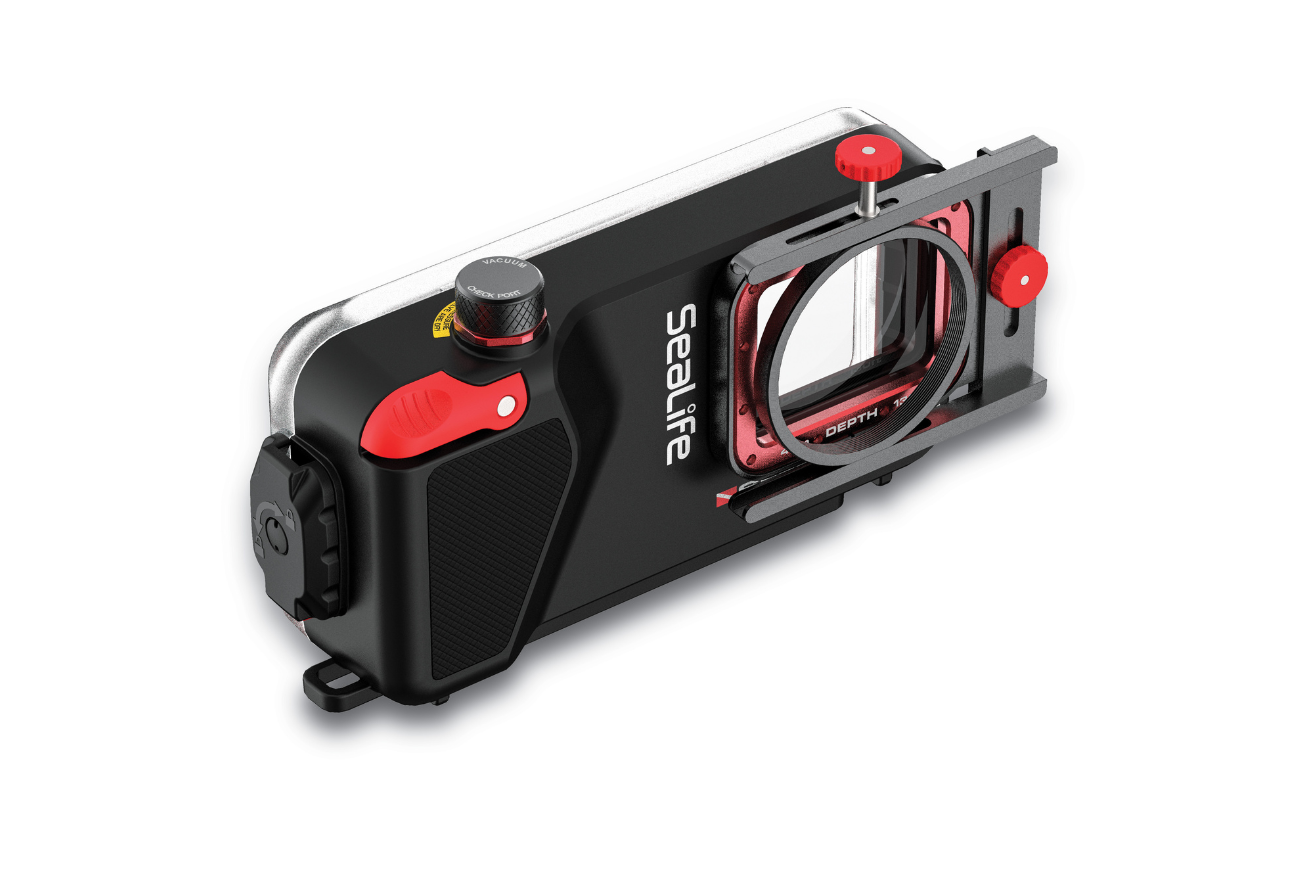
Highlight Reel
Accessories
Some housings have adapters that enable users to add wet lenses. Test divers especially liked SeaLife’s single-piece adjustable adapter. It allows for any 52 or 67 mm threaded lens to be mounted, making it easy to attach wide-angle or macro lenses to capture any underwater encounter from gigantic whale sharks to itty-bitty nudis.
Auto-Vacuum Port
Although we didn’t have any issues with leaks, the addition of a vacuum port instantly boosted confidence when submerging phones underwater. Even better was the builtin, automatic vacuum port on the Oceanic+, which ensures users won’t skip the vacuum-testing process and won’t lose any of the pieces.


